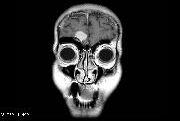Learning Objectives
- Cerebral venous thrombosis often presents with symptoms of headache, focal neurological symptoms, or a seizure
- The most commonly affected sinuses are the transverse sinus and the superior sagittal sinus
- Anticoagulation is the treatment of choice
History
A 42 year old lady who is 7 months pregnant develops a severe, diffuse, throbbing headache one day and reports to the hospital. She has nausea and vomiting and she is admitted for further evaluation. She denies sensitivity to light, and she denies a history of headaches, trauma, infection, travel history, or changes in her medications. She tries acetaminophen and prochlorperazine for her symptoms and they provide no relief.
She is taking only a prenatal vitamin. She has no allergies to medications.
She has a medical history of infertility. This is her second successful pregnancy. Each time she had infertility treatments with ovarian stimulation and IVF.
Family history is pertinent for DVT in her mother. Her father has discoid lupus.
She does not smoke, drink alcohol or use recreational drugs. She is trained as a law clerk but she has not been working for three years.
Review of systems indicates back soreness, polyuria, and insomnia, but she denies trouble with abdominal pain, irregular bowel movements, trouble breathing, rashes, chest pain or palpitations, bleeding, or visual disturbance.
Examination
Her temperature is 99.0 F, her blood pressure is 133/82, and her pulse is 76. She is alert, lying on a bed in a darkened room. Her awareness and orientation are normal. Carotid and cardiac auscultation are normal. Pupillary and funduscopic exams are normal. She has normal speech. Eye movements are conjugate and normal. Facial sensation and movements are normal. You find normal strength and deep tendon reflexes in the arms and legs. Sensation to touch is normal on both sides. Finger nose finger movements are normal. She declined the gait examination.
Localization and Neuroanatomy
This is a 42 year old pregnant lady with a headache and a normal neurological exam. She does not normally have headaches, but she does have symptoms of a migraine headache. It is somewhat unusual to develop a first time migraine at this age. Possible causes of these symptoms besides migraine may include pre-eclampsia, cerebral hemorrhage (due to aneurysm, etc.), pituitary apoplexy, cerebral venous thrombosis, and sudden changes within an occult cerebral neoplasm.
Because she is pregnant, the probability of CVT is higher than usual. Headache is the most common symptom of CVT, but CVT may also cause focal or severe global neurological symptoms. The superior sagittal sinus is the most common site of CVT. This may result in symptoms of hemiparesis or hemisensory deficits due to ischemia of a nearby eloquent cortex. The transverse sinus is a common site of CVT. Visual impairment may occur in this setting. When deep cerebral veins (vein of Galen, straight sinus) are affected, rapid clinical deterioration may occur due to damage of the thalamus or basal ganglia. Elevated CSF pressure occurs in CVT. This may present with papilledema or abducens nerve palsy.
Diagnosis
When CVT is suspected, MRI of the brain and venography are most often used. The MRI first may screen for alternative causes. Sometimes CVT causes small strokes associated with reduced venous drainage. Bilateral strokes are particularly suspicious for this etiology. MR or CT venogram should demonstrate a venous flow void if CVT is the correct diagnosis.
As in other cases, the routine blood count is a useful test. White blood cell count and platelet count are relevant to this condition. PT and PTT help screen for coagulation disorders and determine the candidacy for coagulation therapy. Specialized testing for coagulation factors and enzymes may be indicated in some cases. Serum D-dimer is not considered to be a very useful test in making the diagnosis.
Several conditions are associated with CVT. These include dehydration, smoking, obesity, pregnancy, thrombophilia, infection, history of DVT, and certain kinds of neoplastic diseases. Elevated homocysteine level, decreased activity of protein C or protein S, Factor V Leiden gene mutation, anti-phospholipid or cardiolipin antibodies may be useful in cases when another cause is not found.
Treatment
Cerebral venous thrombosis may be treated with hydration, observation, anticoagulation, or a surgical intervention. For small thromboses, observation and hydration may be sufficient. Glycerol and other intravascular diuretic medications may help to reduce the raised intracranial pressure. Most patients with significant thrombosis are treated with anticoagulation. Low molecular weight heparin is often used, even in pregnant patients. Intravenous heparin is also used at times. Alternate coagulation may suit patients with intolerance for heparin-like products. Sinus recanalization tends to occur after 3-12 months of continuous treatment.
When hemorrhage occurs in the setting of CVT, anti-coagulation remains the therapy of choice. The dose may be cautiously adjusted in such a case. Surgery is useful in cases of re-bleeding, cases resistant to medical therapy, or in a severe clinical setting (e.g. coma). Catheter-based medicine disbursement, mechanical retrieval and sometimes open cerebrovascular surgery may be useful in these cases.
Review Questions
- Cerebral venous thrombosis may cause symptoms of:
a. headache
b. visual loss
c. seizure
d. coma
e. all of the above - Which of these venous structures is most often affected by CVT?
a. Vein of Galen
b. Sigmoid sinus
c. Cavernous sinus
d. Superior Sagittal Sinus
e. Internal Cerebral Vein - You evaluate another patient and find they have a SSS thrombosis with associated hemorrhage near the anterior left parietal lobe. Given a hemorrhage is present, but there are no symptoms, you choose to:
a. continue observation and hydration
b. administer glycerol
c. administer Factor VII, to help prevent further bleeding
d. administer low molecular weight heparin
e. recommend a neurosurgery consultation
